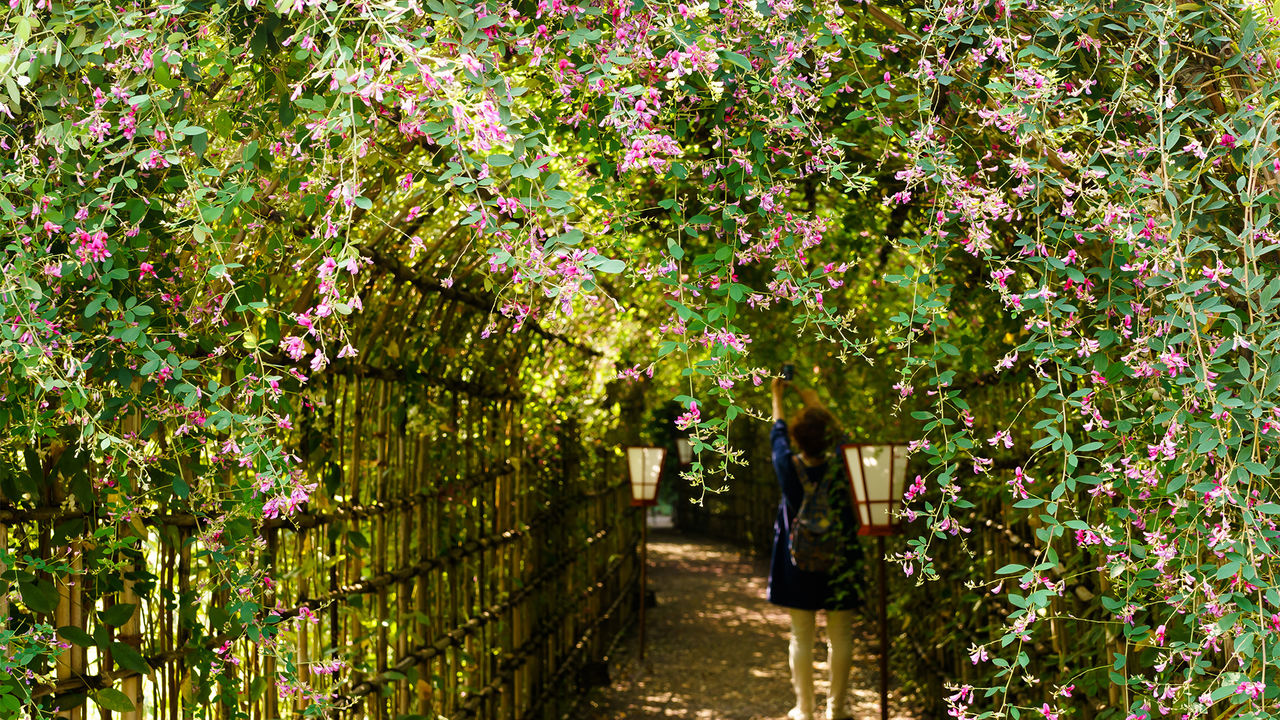
“Hagi” Blooms Bring a Hint of Autumn
Guideto Japan
Culture- English
- 日本語
- 简体字
- 繁體字
- Français
- Español
- العربية
- Русский
The Most Autumnal of Flowers
Once the brightly colored blooms of summer bid us farewell, the more modest flowers of the fall, such as cosmos, cluster amaryllis, and autumn bellflower, start to show their faces. The most typical of all fall flowers in Japan would have to be hagi, or Japanese bush clover. It is not a showy bloom. Indeed, the Japanese character used to write it (萩) says it all—the grass radical sits atop the character for fall.
Not many people can readily call to mind an image of a hagi flower. It is common in the countryside, but not so easy to find in Tokyo. And yet, there is actually a little-known hagi highlight in central Tokyo—the hagi tunnel in the Mukōjima Hyakkaen Garden in Sumida, northeastern Tokyo.
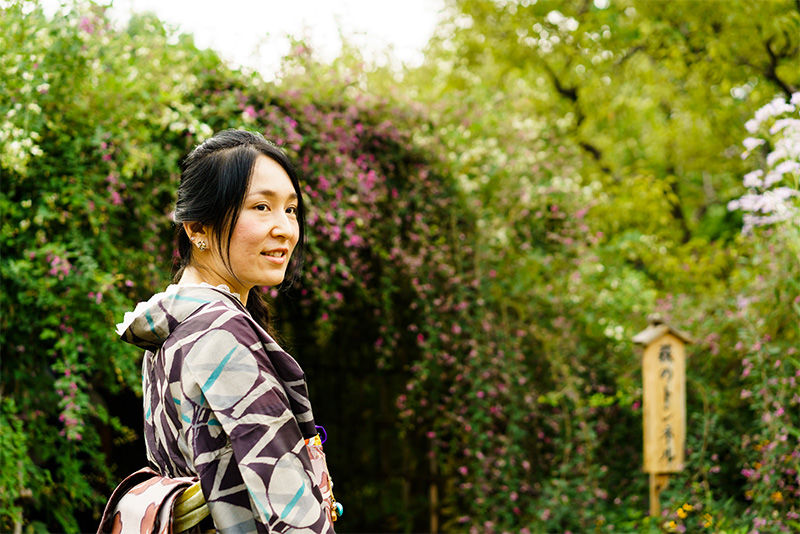 A kimono-clad visitor matches the ambience of autumnal hagi.
A kimono-clad visitor matches the ambience of autumnal hagi.
We enter through the garden’s traditional wooden gate on a September day that feels more like midsummer. The grounds are lush with foliage. After following a narrow, winding path for a bit, we find an open area in the center of the gardens and a sign for the hagi tunnel. Indeed, before us soon appears an arched bamboo trellis with long hagi vines growing luxuriantly over it to create a verdant tunnel.
 The entrance to the hagi tunnel.
The entrance to the hagi tunnel.
Looking in from the entrance, the sunshine creates a dazzling display in this bower of foliage and flowers. As we walk through the two-meter high passage, flower-laden hagi vines hang down between the bamboo supports to form a tunnel of reddish-purple, pealike blooms some 2–4 centimeters across. Hagi are small and unassuming flowers, but nonetheless have a refined grace that makes you want to stop and admire them.
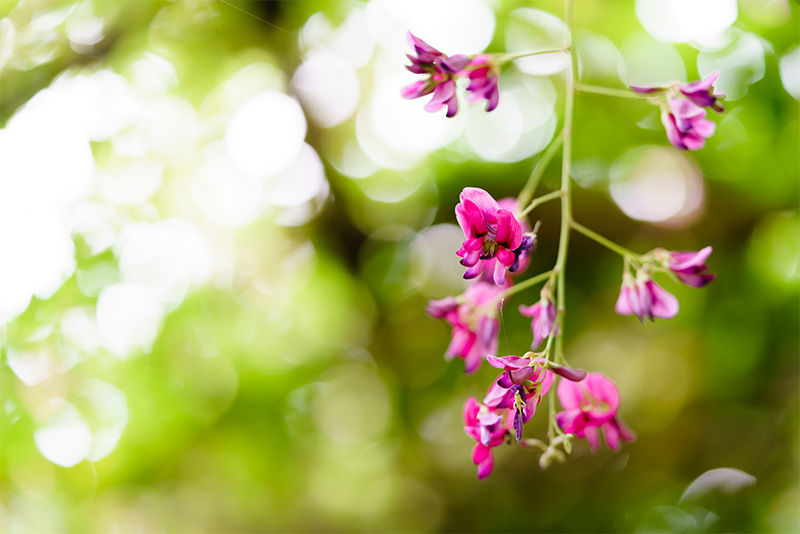 Part of the flower’s appeal is its multiple cascading blooms.
Part of the flower’s appeal is its multiple cascading blooms.
One of the Seven Flowers of Autumn
Hagi flowers are also one of the seven flowers of autumn, a classic grouping derived from ancient Japanese poems.
Flowers blossoming
in autumn fields—
bending my fingers,
I count them one by one
to find they number seven.There are bush clover,
pampas grass, arrowroot,
dianthus flowers.
Patrinia there is
and also thoroughwort
and the bellflower.
The seven fall flowers were enumerated by the poet Yamanoue no Okura (ca. 660–ca. 733) in these verses published in the oldest collection of Japanese poems, the Man’yōshū. This garden grows all seven of the flowers, and all but kuzu, Japanese arrowroot, and nadeshiko, dianthus, were about to start blooming on our visit.
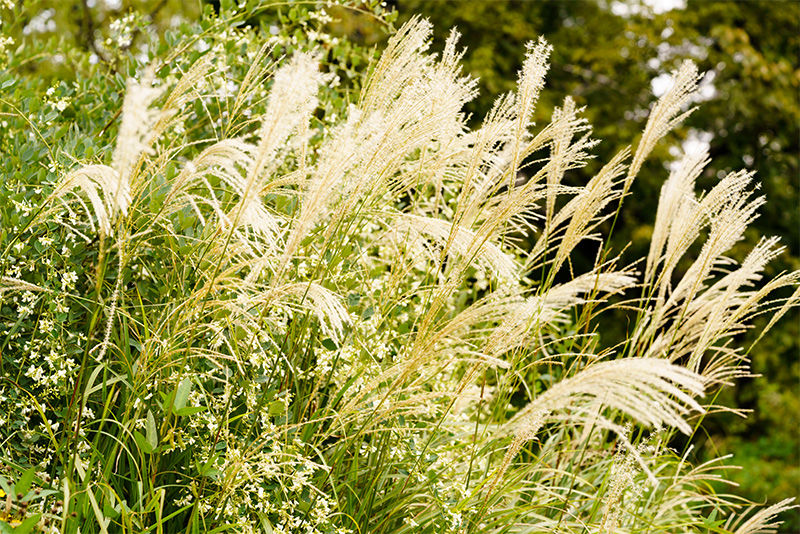 Susuki, or Japanese pampas grass, is also called “tail flower” in Japanese, by virtue of its similarity to a horse’s tail.
Susuki, or Japanese pampas grass, is also called “tail flower” in Japanese, by virtue of its similarity to a horse’s tail.
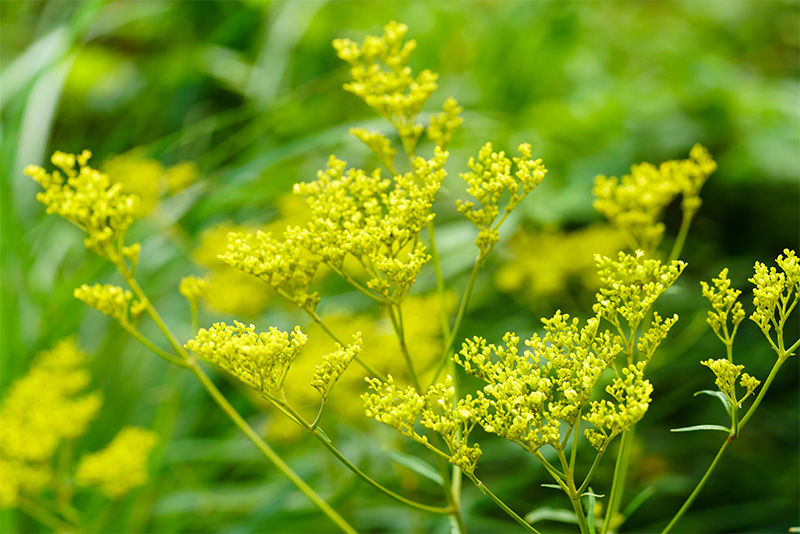 Ominaeshi, patrinia or golden lace, is written with the characters for “courtesan flower” in Japanese, as it was considered so beautiful it astonished beauties themselves.
Ominaeshi, patrinia or golden lace, is written with the characters for “courtesan flower” in Japanese, as it was considered so beautiful it astonished beauties themselves.
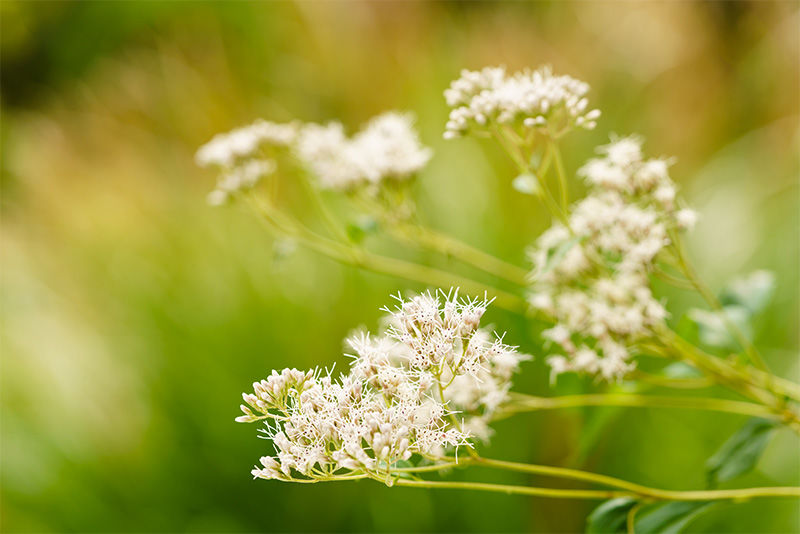 The small flowers of the fujibakama, or thoroughwort, are said to resemble the shape of a hakama, or traditional divided skirt.
The small flowers of the fujibakama, or thoroughwort, are said to resemble the shape of a hakama, or traditional divided skirt.
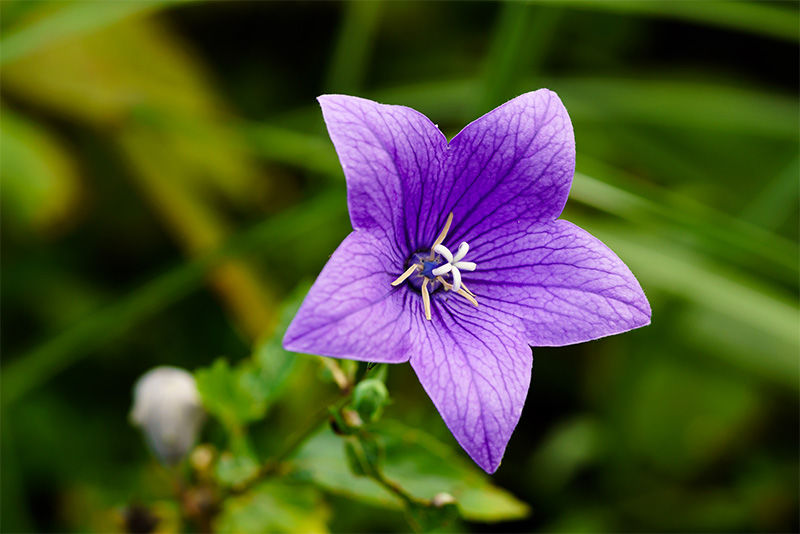 Asagao, the bellflower, is not to be confused with the more common asagao, which means morning glory.
Asagao, the bellflower, is not to be confused with the more common asagao, which means morning glory.
The seven flowers of autumn are deeply connected with the harvest moon festival, a celebration of thanks for the fall harvest. The harvest moon rises on the fifteenth night of the eighth month in the lunar calendar. With little moisture in the atmosphere, the air is especially clear, and it is considered the best day in the year to appreciate the moon’s beauty. Moon-viewing parties have been held on the night of the harvest moon (September 24 in 2018) down through the ages.
At Hyakkaen’s moon-viewing event, an offering of 15 rice dumplings and taro is laid out under the moonlight, together with each of the seven fall flowers. Susuki pampas grass is one of the best known, and is there as a symbol of a good harvest because of its resemblance to an ear of rice. With its long stems, hagi, a member of the pea family, is thought to represent the chopsticks of the deities. It is said that imperial moon watchers, including the tenth-century Emperor Murakami and nineteenth-century Imperial Princess Kazunomiya, made holes in taro with hagi chopsticks to better view the moon.
The Literati and Hyakkaen
Hyakkaen boasts blooms in profusion through all four seasons, but it also harbors other natural attractions. With its abundance of plant life tended as naturally as possible, the Japanese bush warbler (uguisu), the great tit (shijūkara), and even the odd kingfisher (kawasemi) can be spotted in the grounds. The pleasing tones of crickets and bell crickets (suzumushi) not often heard in Tokyo these days are also an aural treat for visitors.
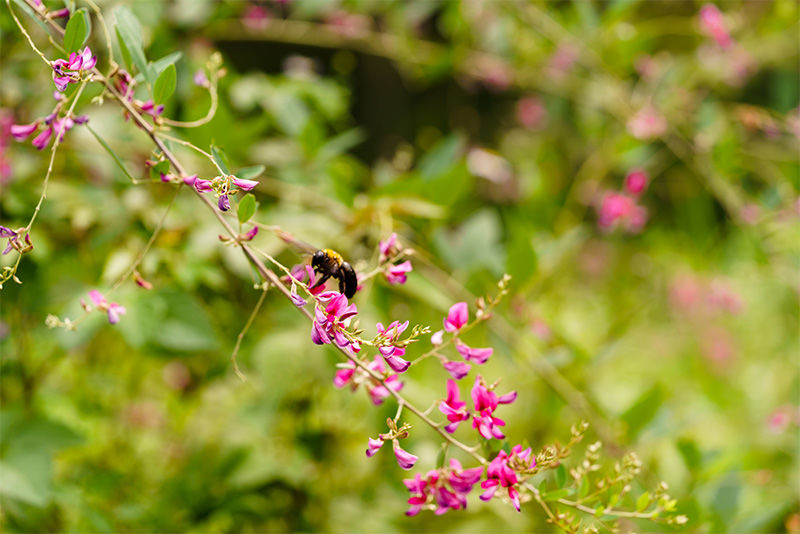 Bees are said to collect hagi nectar before hibernating for the winter.
Bees are said to collect hagi nectar before hibernating for the winter.
The Hyakkaen Garden opened in 1809, at a time when the townspeople’s culture of Edo, now Tokyo, was blossoming. The man behind the project was a former antiques dealer called Sahara Kikuu, who obtained the support of his writer, artist, and other literati friends to create it on the grounds of the former residence of a warrior retainer. Unlike the splendor of gardens built by powerful warrior lords, it became known as a garden rooted in cultured tastes.
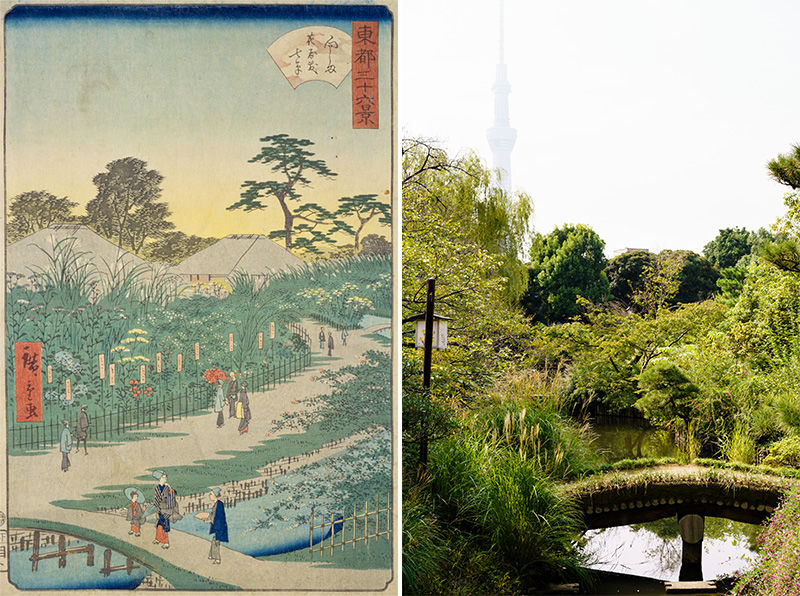 Seven Flowers of Autumn from Thirty-six Views of Edo by Utagawa Hiroshige II (1826–69).Enjoy the contrast of a grassy, earthen bridge and pond in Hyakkaen in the foreground with Tokyo Skytree towering behind.(right)
Seven Flowers of Autumn from Thirty-six Views of Edo by Utagawa Hiroshige II (1826–69).Enjoy the contrast of a grassy, earthen bridge and pond in Hyakkaen in the foreground with Tokyo Skytree towering behind.(right)
Hyakkaen is not much bigger than a soccer field, but at Hagi Festival time it can attract as many as 20,000 visitors. The garden attracts visitors who actively paint, sketch, or take snapshots, but it also offers a hidden oasis of calm in the Tokyo metropolis.
Hyakkaen’s hagi tunnel only made its début in 1910. The nearby Sumida River had flooded that summer, and the garden was all but destroyed by the lingering flood waters. Although it survived, it was in financial trouble, and the tunnel was conceived as a way to lure paying visitors back.
A Score of Hagi Vareieties
On careful inspection, the hagi tunnel reveals two different kinds entwined around its bamboo trellis, the shrubby yamahagi (Lespedeza bicolor) and the Miyaginohagi (Lespedeza thunbergii). There are almost 20 different varieties of hagi carefully planted around the grounds so that they will all flower at once. The kehagi (Lespedeza patens) and kihagi (Lespedeza buergerii) are but two. It is easy to miss some, but a hagi treasure hunt around the grounds will reward the observant visitor.
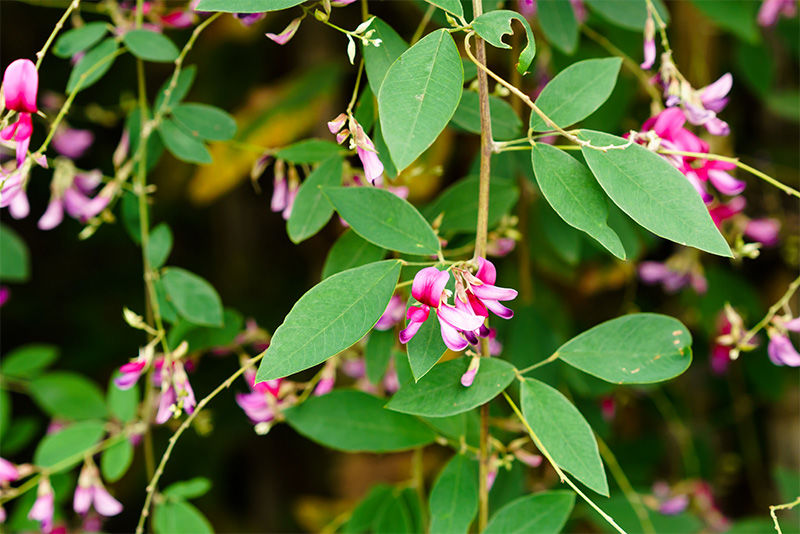 The Miyaginohagi is distinguished by its pointed leaves and its large, crimson-purple flowers. It is one of the varieties planted in the hagi tunnel.
The Miyaginohagi is distinguished by its pointed leaves and its large, crimson-purple flowers. It is one of the varieties planted in the hagi tunnel.
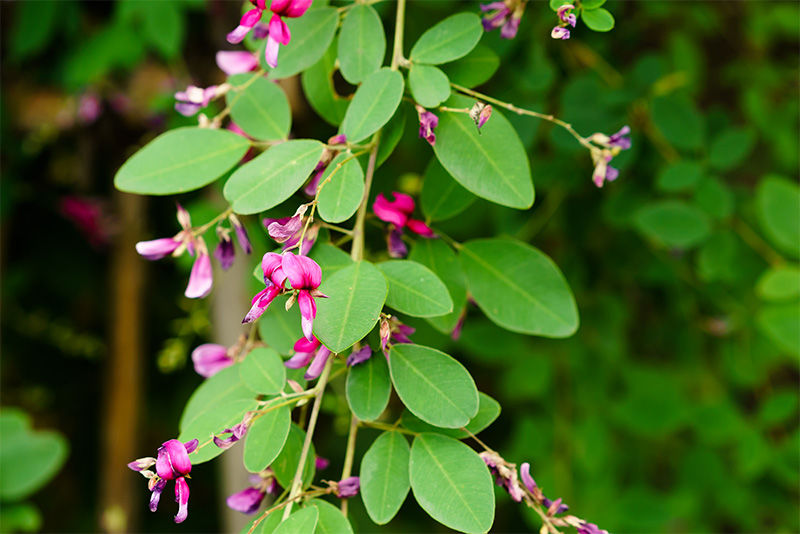 Yamahagi has more rounded leaves than the Miyaginohagi. Although found all over Japan, it and the Miyaginohagi are the most likely to be seen in the Tokyo area. It is the other variety in the tunnel.
Yamahagi has more rounded leaves than the Miyaginohagi. Although found all over Japan, it and the Miyaginohagi are the most likely to be seen in the Tokyo area. It is the other variety in the tunnel.
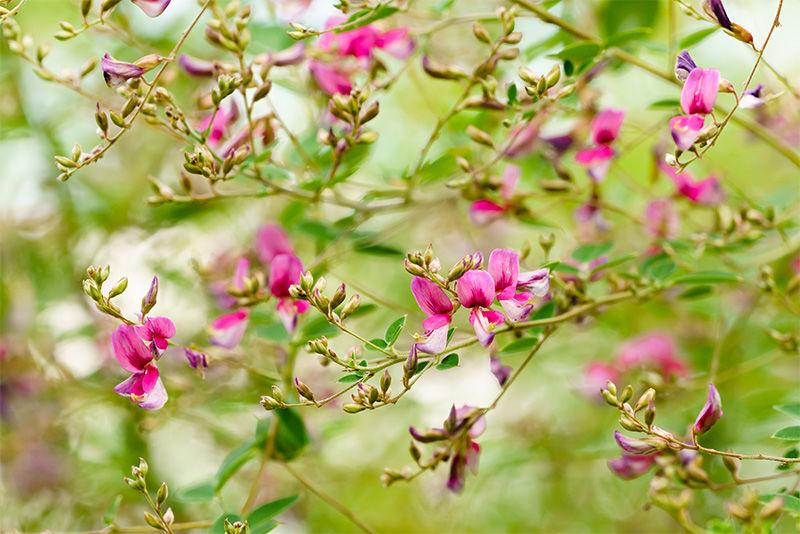 The Edoshibori hagi has a beautiful flower with a purple tie-dyed pattern on a white ground. It is a non-weeping variety.
The Edoshibori hagi has a beautiful flower with a purple tie-dyed pattern on a white ground. It is a non-weeping variety.
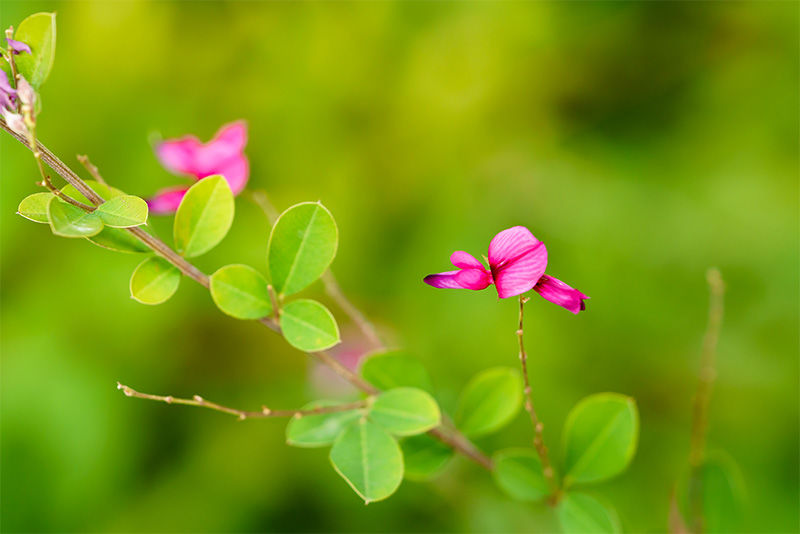 The kehagi has the largest flower of all wild hagi varieties. It is similar to the Miyaginohagi but with more rounded leaves.
The kehagi has the largest flower of all wild hagi varieties. It is similar to the Miyaginohagi but with more rounded leaves.
The Mukōjima area in which Hyakkaen is located is still home to almost 100 working geisha, along with many traditional Japanese restaurants. It also has countless old-time, local businesses offering sushi, soba, Japanese sweets, and Western-style food. You may get a new perspective on Tokyo by strolling the streets of this town with the Skytree tower as its backdrop.
Mukōjima Hyakkaen Garden
The Hyakkaen Hagi Festival is held from mid-September to early October every year, when the hagi tunnel is at its best. The garden comes alive with events such as hagi-themed poetry gatherings and performances of jōruri ballad drama.
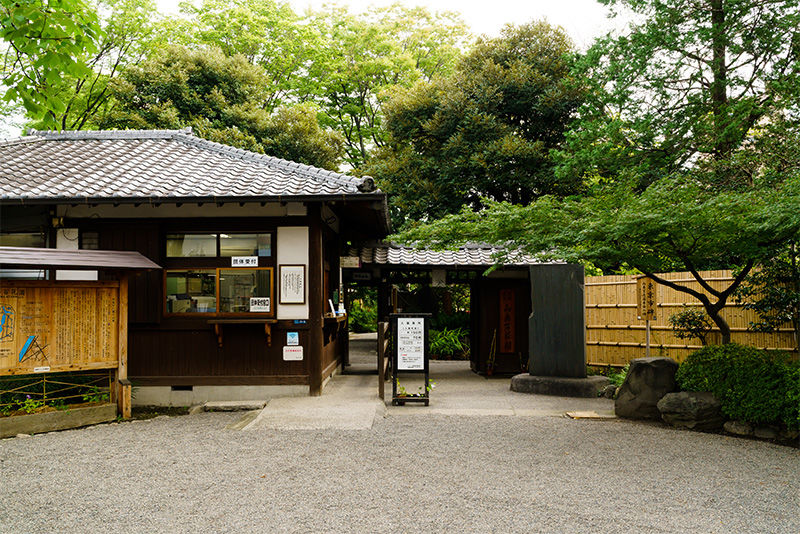 The entrance to Mukōjima Hyakkaen Garden. The reception building at left is an impressive wooden structure.
The entrance to Mukōjima Hyakkaen Garden. The reception building at left is an impressive wooden structure.
DATA
- Address: 3-18-3 Higashi-Mukōjima, Sumida, Tokyo
- tel: 03-3611-8705
- Open: 9:00 am to 5:00 pm (last entry at 4:30 pm)
- Closed: December 29 to January 3
- Fees: General ¥150; Age 65 and over ¥70 (free for children up to elementary school age and junior high school children resident or attending school in the Tokyo metropolitan area; discounts for groups of 20 or more)
- Access: 8 min walk from Higashi Mukōjima Station on the Tōbu Skytree Line, 13 min walk from Keisei Hikifune Station on the Keisei Oshiage Line, 2–3 min walk from Hyakkaen-mae bus stop on the Toei Bus Kameido to Nippori route (#22)
- Multilingual information:
- Website: http://teien.tokyo-park.or.jp/en/mukojima/index.html (also available in simplified and traditional Chinese, French, and Korean)
(Originally written in Japanese. Banner photo: People flock to Mukōjima Hyakkaen to enjoy the bush clover in full bloom. Reporting and text by Abe Manami; photos © Miwa Noriaki.)